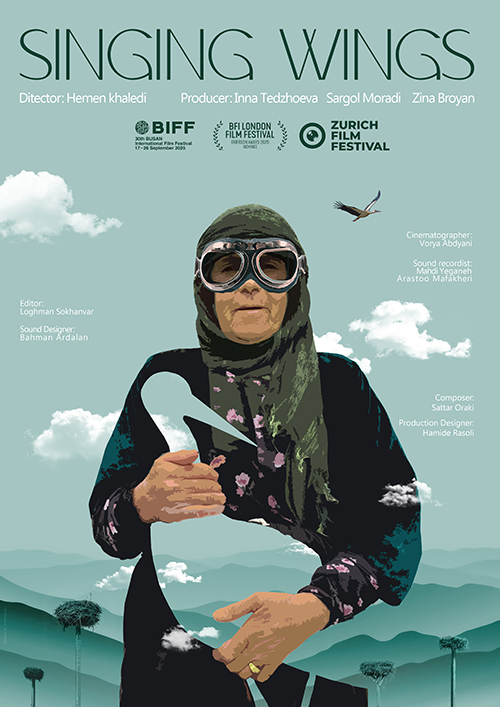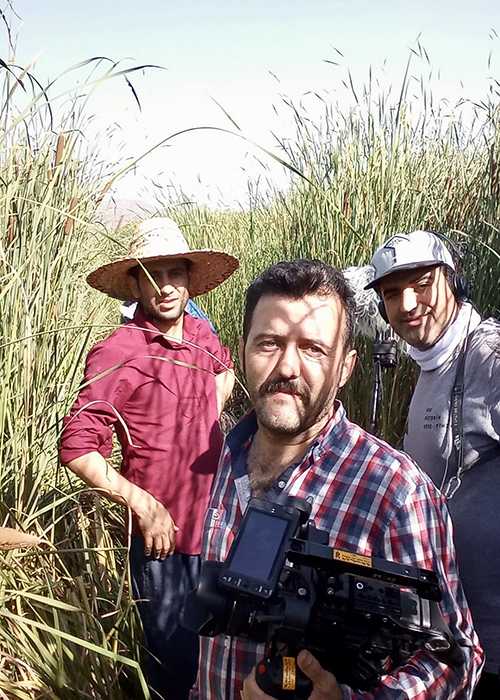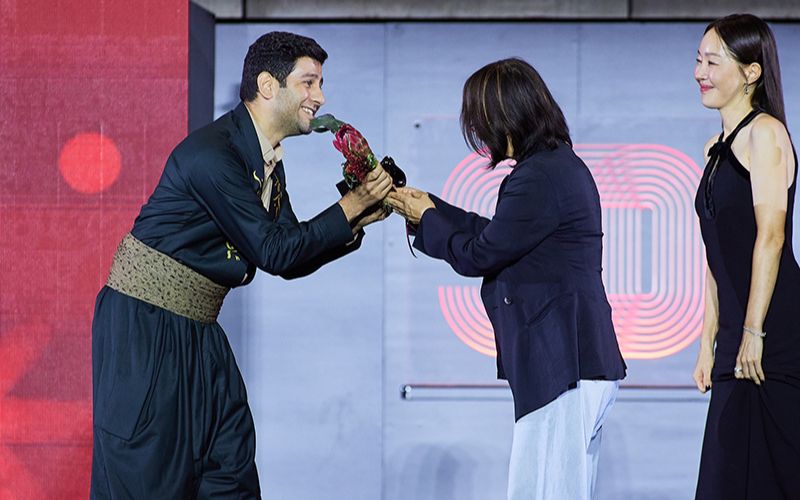[MISSION] The BIFF Mecenat Award Winner Hemen Khaledi on His Journey with “Singing Wings”
2025-10-24The 30th Busan International Film Festival was held in late September, and Iranian filmmaker Hemen Khaledi received the Mecenat Award for Best Asian Documentary in the Wide-Angle section for his film “Singing Wings”, a co-production between Iran, Belgium, and Georgia.
Hemen Khaledi began his filmmaking education at the Iranian Youth Cinema Society while also studying physical geography at university. With a background in theater acting, he decided to continue his studies in cinema at the master’s level. He started his professional career as a photographer and assistant to a director, cinematographer, and sound recordist, gaining experience gradually.
His earlier work, “Balora”, was screened at several international film festivals, including MEDIAWAVE International Film Festival, Early Bird International Student Film Festival, and has won multiple awards at Apricot Tree International Documentary Film Festival and Slemani International Film Festival.
“Singing Wings” is Hemen Khaledi's first feature film, which had its world premiere at the Busan International Film Festival and was also selected for the Zurich Film Festival (ZFF) and the BIF London Film Festival.

“Singing Wings” tells the story of Khadija, a Kurdish elderly woman, who strives to save an injured stork left behind during migration, while simultaneously facing the challenge of her daughter’s migration abroad.
In a voice-call interview conducted between October 4 and 6, Hemen Khaledi discussed how the idea for this documentary came to life and outlined his general approach to documentary filmmaking: “As a documentary filmmaker, I always have various ideas in mind that I research and explore. I was studying storks, their migration patterns, and their similarities and differences with humans when I came across a village in Kurdistan where the people coexisted very peacefully with these birds. I met an elderly woman named “Khadija”, who, along with her family, had extensive experience caring for injured storks and also collaborated with local NGOs active in this field.”
Hemen Khaledi, referring to his meetings with Khadija during his research, continued, “One day, while I was interviewing and talking with Khadija, I found out that her daughter was in the process of migrating to the United Kingdom. It seemed that she, too, was emotionally preoccupied with the issue of migration. The intersection of her personal experience with the migration of the storks was deeply inspiring for me, and that’s how the main idea of the work was formed. I shared it with Loghman Sokhanvar, one of Iran’s talented editors who has always supported young filmmakers, and that marked the beginning of the production of my first feature film.”
According to the director, he began the pre-production phase of the project by researching storks, their behavior, the injuries they face during migration, their recovery process, the lives of local villagers, their interactions with storks, and the rituals and festivals associated with these birds, which took about two years. “The research included both fieldwork and library studies. Sometimes I had to contact veterinarians, physiotherapists, and radiologists for animals abroad to ask questions about storks’ behavior and the types of fractures and injuries that occur to them. In the area where we were filming, there were high-voltage power lines that the birds often collided with during migration, leading to serious injuries. This issue was also a major concern for the residents of the surrounding villages.”

In order to gain greater access to relevant information and conduct more in-depth research, director Khaledi and his wife moved to the filming location village for several months. This allowed him to become more familiar with Khadija’s family and to carry out broader research for his documentary. “Since Kurdistan is my homeland, I could easily connect with the local people. However, because commuting from Tehran to the village was difficult, I decided to live there for a few months so I could get to know Khadija’s family better. One day, I asked them if they would be willing to help another stork should one need help again, and they gladly agreed. For them, it was nothing unusual. “
He stated that living in the village created a much closer bond between him and Khadija’s family, saying, “We had become like one family. Because of this, we gained a much deeper understanding of their lives and could anticipate how they might react in different situations. As a documentary filmmaker, I found this both fascinating and inspiring.”
Hemen Khaledi, discussing the visual style of the film, emphasized that he and his team consistently aimed to ensure that Khadija and her family did not feel disturbed or uncomfortable by the presence of the documentary crew. “It was very important to me that they felt good about this collaboration. That’s why I tried to make the camera feel like a member of the family. We filmed from a respectful distance, avoiding unnecessary camera movement. Most of the filming was done with a stationary camera on a tripod. I also tried to keep the crew as small as possible.” He explained that the crew was divided into two groups. “The main team, consisting of the director, cinematographer, and sound recordist, was on the filming scene, while the second team, which included other crew members, worked at a distance, either in the courtyard, the alley, or a neighboring house. We always tried to schedule the filming times and duration according to the characters’ daily routines and personal comfort, so they would feel comfortable.”
Hemen Khaledi mentioned that he tried to make the camera an observer and recorder of Khadija's and her family's life, adding, “In scenes where the characters were moving, we would follow them rather than forcing them to move toward the camera. In other words, the characters were the driving force behind the camera’s movement. Of course, some of the camera movements were also influenced by the birds’ movements, the architecture of the house, and the lifestyle of the residents, which sometimes required tilt-up or tilt-down shots depending on the situation.”
In response to a question about the challenges of making the documentary, the director pointed out the difficulty of securing funding. “We didn’t have a major investor, and since the “Singing Wings” was my first feature film, I didn’t have much experience in this area. But the empathy and support of my colleagues and crew helped me overcome this challenge.”
He cited the advanced age of the documentary's main characters, Khadija and her husband, as well as working with children, who are very difficult to manage, as other challenges in making this documentary. Moreover, filming the “Singing Wings” took place throughout the year and across different seasons, and the extreme temperature variations in the region created numerous technical problems. “The area has very hot summers and very cold winters, which repeatedly caused technical issues during filming. We lost several sensitive scenes because the camera stopped working in the summer heat, and in the winter, we had to take special precautions to prevent unforeseen incidents.”
Hemen Khaledi referred to one of the most challenging incidents during the making of the documentary, which presented them with a difficult choice: “During filming, the main character, Khadija, had an accident and broke her leg. We were filming when this happened, so the accident was captured entirely on camera. However, using this footage during editing became a major dilemma for us. Placing the two events—the stork’s broken wing and Khadija’s broken leg—side by side was deeply meaningful, but we weren’t sure whether the audience would find it believable. Even though this accident happened in reality, we worried that viewers might not accept it. In the end, we decided to omit parts related to this accident to preserve the realism of the film.”

He stated that this documentary holds a special place for him as a director. “Although I studied cinema and have several years of experience working behind the scenes, directing my first feature documentary was very challenging and difficult because I had little prior experience as a director. Nevertheless, with the collaboration of my film crew, we were able to achieve an outstanding result. The fact that my directorial debut won the top documentary award at the most important film festival in Asia has uniquely distinguished it for me." He described every work of a director as being like their child and added, "While making “Singing Wings” I was awaiting the birth of my children. Now, seeing both my children and my film growing up together is incredibly fascinating and sweet."
When asked how he would describe his film in one sentence, Khaledi pointed out proverbs from the Kurdish culture that highlight the similarities between humans and animals, reflecting the deep connection between people and nature. "In my childhood, one of the elders in our family would always quote a proverb: “What is a human? A bird without wings”. Her saying, and why she compared humans and birds, always occupied my mind. While I was researching for the film, I thought about this phrase a lot, and I can say it greatly influenced me throughout the filmmaking process. I will always remember it as the golden line for my film."
Hemen Khaledi described his experience at the Busan International Film Festival as fascinating and valuable, listing the enthusiastic presence of Korean audiences and interacting with them as some of his most memorable moments from the festival. "Watching the film alongside Korean audiences was a captivating experience. They connected deeply with my film and stayed until the very end. For filmmakers, especially documentary makers, having viewers remain in the cinema until the final moment of the screening is incredibly important. The audience actively participated in the Q&A session and even shared their moments from the film screening with me on social media. This level of enthusiasm from the audience is truly remarkable."
He cited the Busan International Film Festival’s comprehensiveness, in showcasing various forms of cinema, including short, feature, narrative and documentary films, as well as its film market and film academy for training young filmmakers, as its unique characteristics. Hemen Khaledi added, “All of these elements together have given the Busan International Film Festival a special place among other festivals and have provided filmmakers, especially Asian filmmakers, with the opportunity to meet producers, distributors, and various film platforms, and to build connections with them.”
The director evaluated the role of festivals like the BIFF in promoting documentary cinema very positively and emphasized, "Although the presence of documentary films in the competition section alongside narrative films is valuable, documentary film deserves even more attention so that different perspectives and new voices in this field can be seen and heard. In the age of artificial intelligence, where we are witnessing fake and artificial productions, the need to focus on real narratives is felt more than ever. It is true that we live in a digital age with advanced technologies, and we must stay up to date, but to the same extent, we need to understand each other more as human beings and confront realities in the real world. Documentary cinema is one of the best tools for conveying and understanding these realities."
He discussed the position of documentary in today's film industry and the opportunities and challenges it faces, reaffirming the role of artificial intelligence in this field and said, "One of the most significant challenges facing cinema today is the entry of artificial intelligence into this arena, and documentary filmmaking is no exception. AI has a dual function: on one hand, it can be helpful in certain areas and reduce costs. On the other hand, through inappropriate use, it can convey incorrect information to the audience and foster uncertainty about reality and truth. Therefore, documentary cinema, which is based on truth and realism, is more important today than ever. It seems essential to have mechanisms that can distinguish films made with real material from those generated by AI, especially in documentaries. Because it is the audience's right to know how the work they are watching was made."
At the end of this interview, Hemen Khaledi referred to the wide range of subjects that documentary films can address and said, “Documentary film has the capacity to cover a variety of topics — scientific, social, artistic, and even current issues and the concerns of society. As a result, the audiences, depending on their interests and needs, can benefit from it at any age. Since documentary filmmaking is based on research and investigation, a documentary filmmaker, like a researcher or scientist, can present hypotheses and suggestions about the subject they explore. This very characteristic gives the documentary genre its unique dynamism and beauty.”
How about this article?
- Like5
- Support0
- Amazing0
- Sad0
- Curious0
- Insightful0


